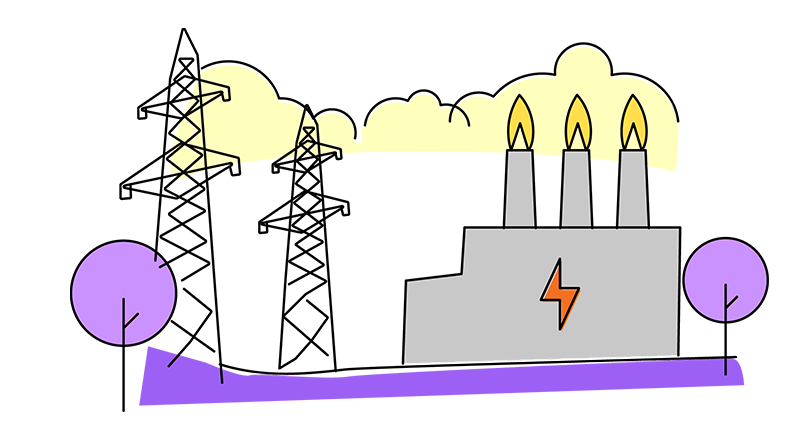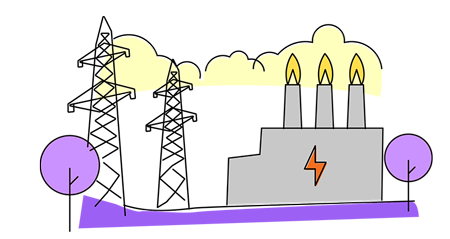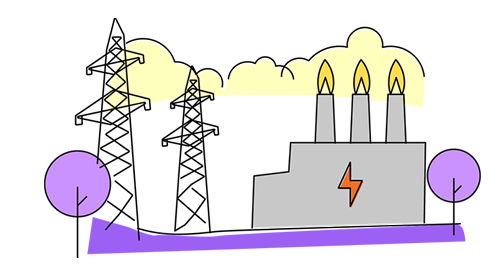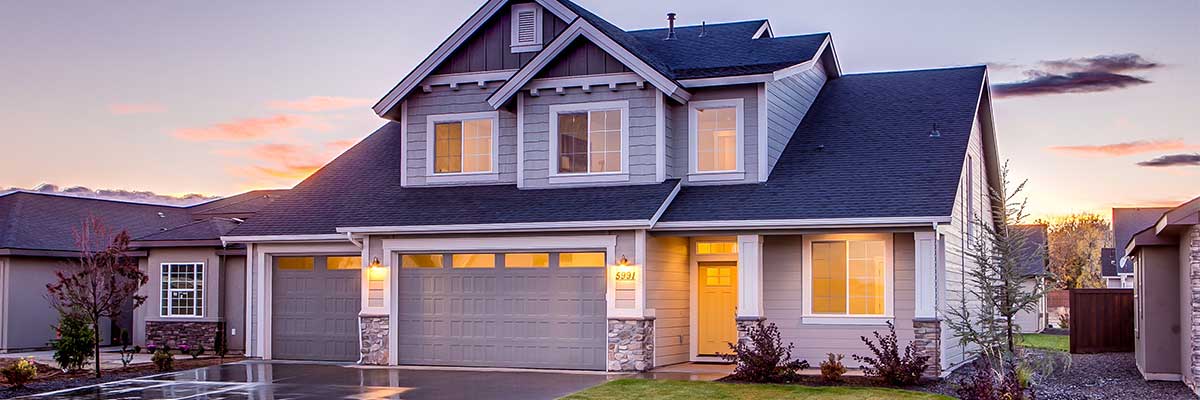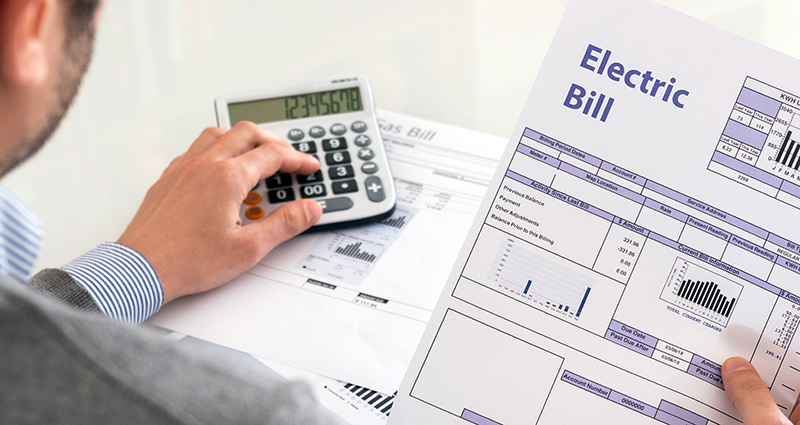What is natural gas?
Natural gas is actually methane, a hydrocarbon gas, composed of one carbon atom and four hydrogen atoms (CH4), and is a product of natural decay and decomposition of organic material. Since organic material takes time to thoroughly decompose, natural gas forms underground either as a byproduct of bacterial organisms or from extreme pressure and heat in deeper rock layers. Deep deposits of natural gas are usually found at the same levels as shale and coal.
The gas seeps naturally under its own pressure up through rock fissures to the ground surface. In swampy or boggy environments, it can be ignited as a Will-o'-the-wisp, Jack-o-lantern—so named from old, supernatural myths that emerged to explain the phenomenon—or as "ignes fatui" when the naturally occurring phosphine (PH3) and diphosphane (P2H4) gases that accompany it combust upon contacting oxygen in the air.
When was natural gas first used?
Humans first harnessed the use of natural gas over 3,000 years ago. Around 1,000 BC, legend has it a goat herd discovered a burning natural gas seep on the slopes of Mt. Parnassus in Greece. Deemed a miraculous gift of the gods, a temple was soon established. Famed as the Oracle of Delphi, priestesses would divine the future by inhaling the seep's fumes — among them ethylene. Meanwhile, the Chinese exploited natural gas before 400 BC in Szechuan where it was a byproduct of their salt gathering process. Brine wells were dug several hundred feet, and the water was evaporated for the salt. When natural gas was discovered, it was captured and run through bamboo pipelines to sites where it was burned to speed up brine evaporation.
Where is natural gas found in the United States?
Natural gas is produced in 32 states, according to the Department of Energy, accounting for about 4 percent of total reserves in the world. While gas formations are spread over much of the country, over half the gas produced in the United States comes from just five states: Texas, Oklahoma, New Mexico, Wyoming and Louisiana. Gas travels through pipelines from producing states to non-producing states, a fact that proved to have major commercial and regulatory implications as the domestic natural gas market developed and evolved.
The history of the natural gas industry in the United States
Natural gas was first scientifically identified by Alessandro Volta, the father of the battery, in 1776 and between 1792 and 1798, inventor William Murdoch began experimenting with coal gas-ification to produce methane for lighting, specifically concentrating on transporting, storing, and purifying gas. Across the Atlantic in 1816, building on coal gas-ification technology developed in Britain. The first private residence in the U.S. illuminated by gas belonged to William Henry, a coppersmith, in Philadelphia, Pennsylvania. In the same year, Baltimore became the first American city with a business, Peale's Baltimore Museum, lit by natural gas lamps. A year later, the city hired Peale's Gas Light Company of Baltimore to begin laying gas mains and erecting streetlamps. At the same time, companies in other cities, such as Boston Gas Light in 1822 and New York Gas Light Company in 1825, began feeding the fire.
In 1825, a gunsmith named William Hart came to Fredonia, NY to prospect for natural gas and dug a 27-foot well that captured the first bubbles of natural gas production in the Marcellus Shale. Soon, interstate pipelines were built to bring gas from production fields to consumers, and state utility boards began to exercise control. In 1938, the U.S. government began regulating the natural gas industry with the Natural Gas Act. The act gave the Federal Power Commission (FPC) authority to permit construction and set "just and reasonable rates" for the transmission or sale of natural gas in interstate commerce. Meanwhile, production, collection, and sale price to the end consumer were exempt from the law.
A new regulatory regime for the natural gas industry
In 1954, the Supreme Court ruled that producers selling natural gas into interstate pipelines were ”natural gas companies” and thus fell under the regulatory responsibility of the FPC. Suddenly, the FPC faced treating every producer — from big corporation to small wildcat operator— as an individual public utility. To simplify its regulatory process, the agency devised a regional plan that set up temporary low-ceiling prices for the natural gas industry. When energy shortages took the national stage in 1972, President Nixon announced he would push for natural gas price increases "to stimulate development of new reserves and ease the nation's fuel shortage." In 1974, the FPC scrapped its regional planning and instituted a national price ceiling of ¢42/per million cubic feet (mcf) of natural gas. Although this doubled the 1960s regional price, it remained below the market price. Producers saw no incentive to explore for new resources and — even worse — saw no reason to sell to the interstate pipelines.
Producers instead chose another option for the gas industry. Since intrastate sales and prices stayed exempt from the NGA, they were free to sell their natural gas at the market rate as long as it stayed in-state. While producer states (mostly in the South) had plenty of gas, consumer states in the North faced a crisis. From 1975 through 1977, schools and factories closed throughout the upper Midwest and Northeast due to natural gas shortages.
Unbundling the regulatory knot-work of the natural gas industry
In 1977, Congress passed the DOE Organization Act and the Federal Energy Regulatory Commission (FERC) replaced the FPC. The following year Congress passed the Natural Gas Policy Act, enabling FERC to begin the unpleasant task of untangling the regulatory knot-work that had all but strangled the interstate natural gas industry. To get gas flowing to all parts of the country once more, FERC set maximum price ceilings for all wellhead gas. Prices rose throughout the industry and reverberated all the way into the home. But higher prices soon lowered demand and, by 1982, natural gas prices were declining again. In 1985, FERC ended maximum price ceilings for new wellhead gas, deregulating new gas wells. Here at last was an incentive to explore for natural gas.
1985 also saw FERC issuing Order No. 436. While the order was voluntary, this converted pipeline companies from merchants of natural gas to common carriers, meaning pipelines would not take ownership of natural gas but merely provide the transportation service. Local distributors would buy gas directly from producers and only pay the transmission price to the pipelines. Pipelines who participated in what was an open access program no longer needed approval from the FERC for each gas transmission, which allowed them to move gas more rapidly. It also allowed pipelines to use interstate pipelines for intrastate transmissions.
As deregulation began harmonizing supply and demand, FERC issued Order No. 636 in 1992 to complete the transition to a responsive market system, making the essence of Order No. 436 a permanent requirement for all pipeline companies. Thus, the new regulatory framework emerged governing the natural gas industry.
Deregulation, markets, and choice: the gas industry’s modern market
In short order, market centers were set up at pipeline hubs that allow interstate, intrastate, and local distribution pipelines to physically connect. This interconnection redirects natural gas from one line to another and, as a result, local distributors now buy natural gas directly from the producers at market hubs at the market rate. If a local utility is buying on the spot market at a city gate market, it will pay a price which includes transportation costs. The gas is then diverted to the distribution pipeline that serves the local utility.
Between 1992 and 1998, natural gas consumption rose by 17 percent, driven in part by lower prices, an expanding economy, and new construction. Pipeline expansion was one of the major factors contributing to price decline, bringing more gas up from the Gulf of Mexico and down from Canada into the northeastern U.S. and the upper Midwest. In 1997 alone, 41 natural gas pipeline projects were placed in service. The industry with the highest growing demand for natural gas was electricity generation. In 1990, Texas utilities generated 97.27 Megawatts (MW) of natural gas. By 2000, that amount had increased to 119.84 MW. Consumption climbed over 4 percent from 22.24 trillion cubic feet (tcf) in 1998 to 23.27 tcf in 2008.
While new pipelines and new gas market centers were all in place to efficiently deliver cheap natural gas to everyone, natural gas production from 1996 to 1999 was almost flat at about 17 tcf annually. Even with demand expanding, domestic producers during the late 1990s were not getting the well head prices they hoped for and were being left out of the profit loop. The EIA's Natural Gas 1998: Issues and Trends cited slumping petroleum prices and foreign competition that left a record 1.2 tcf in storage. Wellhead prices fell 15% and producers kept production low, waiting for a comeback.
Two cold winters, however, in 2000-2001 and then again in 2002-2003, jerked demand back up sharply. In both cases, natural gas production and storage was completely unprepared. Prices in 2001 doubled within one month partly because nearly one-third of utilities had chosen not to hedge against market spikes and began buying on the daily spot markets.
Volatile at any price
Foreign energy demand and cheap foreign natural gas production, as well as overseas crises and wars, added to natural gas price instability throughout the period after 2000. In 2005, Hurricane Katrina heavily damaged the heart of oil and natural gas production in Texas and Louisiana, followed by a cold winter in 2006.
Another spike in 2008 came through rising oil prices and speculation, pushing gasoline prices over $4/gallon. U.S. annual natural gas consumption had risen in 2008 to 23.27 TCF, with a sizable portion going to power generation. When natural gas peaked at $13.69 mmBtu in July 2008, some electricity consumers were paying over 20¢/kWh — resulting in outrageous monthly electric bills. Unable to afford these kinds of prices in an already sour economy, consumer energy demand contracted quickly, and prices rapidly declined.
At the same time, two new technologies were just beginning to change the natural gas industry. First, success in bulk-shipping Liquefied Natural Gas (LNG) had just become a reality, which further opened the U.S. market to imports. Second, and most important, was the maturation of horizontal directional drilling technology that uses a combination of steerable drill head and viscous drill fluid to bore 10,000 to 15,000 feet below ground surface. This technology, coupled with the use of high-pressure water to fracture deep natural gas bearing shale, became known as "hydraulic fracturing" or "fracking". In 2008, the rush to profit from fracking produced so much natural gas that the U.S. market was glutted. By September 2009, natural gas cratered at $2.409 mmBtu. The record warm winter in 2011 would push the price below $2.
The future outlook for choice in gas markets
As of March 2019, shale gas wells in the US production stood at 100.4 billion cubic feet/day from only 1006 rigs. US recoverable reserves are estimated by the EIA to be 1,161 tcf. Based on average annual consumption, that's about a 500-year supply. More power plants are switching from coal to cleaner natural gas and more vehicles on the road are burning natural gas. Consumption will doubtlessly rise even more, requiring more distribution.
While most of the natural gas industry is deregulated, the residential end user has been left out of the deregulation loop in many states. Residential sales still resemble the 1930s when municipal utilities or franchised monopolies serviced consumers. A handful of states do have "unbundled" natural gas markets where a local distribution company maintains pipes and charges for delivery and retail providers buy wholesale natural gas to sell to individual consumers.
The EIA reported that "about 5.1 million of the approximately 35 million residential natural gas consumers with access to choose were buying natural gas from marketers as of December 2009." In the states that have the choice, some problems stem from a lack of marketers present in a region or a lack of consumers choosing providers other than their local utility. While the latter may be due to the continued low cost of natural gas thwarting competition, all in all, the number of participants in these states is building gradually. In time, as consumption grows and more diverse energy sources develop, natural gas choice may be the best way of keeping residential consumer prices stable and within easy reach.























